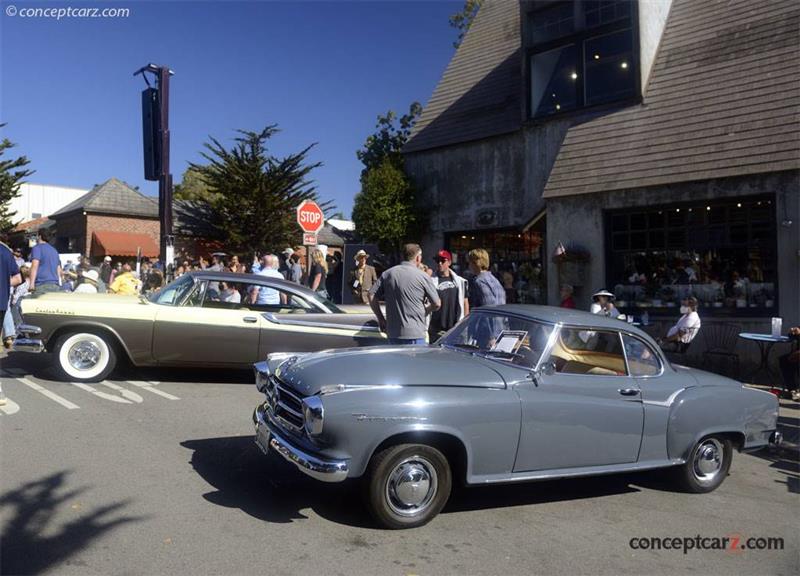The Borgward automobile (Carl F. W. Borgward GmbH) was revered in Bremen, Germany, where it was produced from 1929 until 1961, with the Isabella being produced from June 1954 through 1962. Carl Borgward was a German engineer and designer who progressed from general engineering to the manufacture of three-wheeled trucks under the Blitzkarren and Goliath names in the mid-1920s. Hansa-Lloyd was taken over by the Borgward group in 1931, but it was not until 1939 that the Borgward name first appeared on a motor car.At one point, Borgward was Germany's second-largest automobile manufacturer, and they also produced commercial vehicles along with other manufactured products. After World War II, production resumed with the Lloyd LP300, a small saloon built initially with timber and fabric bodywork, and then in 1952, Borgward introduced Germany's first all-new design of the post-war era, the Hansa 1800. It had a backbone chassis, a fully independent suspension, and an all-synchromesh gearbox. Badged as the 'Hansa 1500' until 1957, the Isabella (its factory code name) would become the most successful Borgward ever, thanks in part to its modern, unitary construction body/chassis and elegant American-influenced styling. More powerful (75bhp) Cabriolet and Coupé versions joined the range and were excellent performers, with a 153km/h maximum speed and exemplary road manners.The Isabella range was sold in a Plethora of guises, including a coupe, two-door saloon, cabriolet, and estate (Combi). The estate wagon was introduced in 1955, followed by a two-door cabriolet and then by the more powerful 75 hp engine. A more sporting two-door coupe equipped with this motor and a slightly shorter greenhouse was developed, including four prototypes with one going to Carl Borgward's wife, Elizabeth, who continued to drive it well into the 1980s. Commercial production of the largely hand-built Borgward Isabelle Coupe began in 1957. A total of 9,537 examples of the Isabella Coupe were made in total.The Trans-Atlantic styling featured plenty of chrome, and was a handsome alternative to Opel and Ford, neatly bridging the gap to more expensive offerings from Mercedes-Benz. Each example wore a Borgward Rhombus, a diamond-shaped emblem with the word 'Isabella' in the center, on the front area. The compact four-cylinder 1,493cc engine was mated to a four-speed, all-synchromesh gearbox via a hydraulic clutch, using a column-change lever typical for cars of the period. In standard guise, the overhead valve four-cylinder engine produced 60 horsepower, while the more potent 75 horsepower 'TS' unit with two Solex twin-choke carburetors was used in the cabriolet and later in the saloon. With independent suspension via coil springs and using a swing axle at the rear, the Isabella handled well and proved a willing performer with excellent road manners.The well-appointed bespoke cabin of the TS Saloon offered space for four adults to travel in comfort and style. Typical Germanic interior features included the padded dashboard and large steering. It had a wide cabin, a large glass area, a clock, and a row of electrical switches on the dash which were ivory in color. The eight switches (a full octave) were in the shape of 'ivories' of a piano keyboard. Production of the Borgward Isabella continued until 1962, when the company entered receivership (due to a controversial bankruptcy), and thus, no replacement followed. During its eight-year production lifespan, Borgward produced 202,862 examples of the Isabella. A recession had left the company short of cash, and neither the Bremen City Senate nor the national government in Bonn would provide the needed bridge loan. Carl Borgward was forced to turn his company over to the City Senate, and they filed for bankruptcy. The final Borgward rolled off the assembly line in 1962.
by Daniel Vaughan | Feb 2022
by Daniel Vaughan | Feb 2022
Similarly Sized Vehicles
from 1961
1961 Borgward Isabella Vehicle Profiles
Recent Vehicle Additions
Performance and Specification Comparison
Isabella Specification Comparison by Year
Year
Production
Wheelbase
Engine
Prices
Related Automotive News

Home again: the last Auto Union Type D twin-supercharger Silver Arrow returns to Audi
Audi Tradition buys back the second Karassik restoration car
Auto Union Type D built in 1939, then lost in the USSR for many years
Thomas Frank, Head of Audi Tradition One of the most emotional moments in our heritage work for AUD...

Toyota Motorsport GmbH Brings Electric Technology to Pikes Peak
Toyota Motorsport GmbH (TMG) will demonstrate its high-performance electric powertrain technology on one of North Americas most demanding motorsport events the Pikes Peak International Hill Climb in Colorado on 8 July.
Last year TMG set a new electric...

BMW back on the DTM grid in 2012
50 wins and countless podium places – after an absence of 20 years, BMW this year resumes its success story in the German Touring Car Masters. Three highly-motivated racing teams are fielding a total of six cars in the most popular national touring car...

Project Visio.M: Electric mass mobility for urban environments.
Electric vehicles powered by electricity from renewable energy sources are an attractive option for mobility within the urban area and beyond. However, previous approaches lead to vehicles that either are too heavy and too expensive or do not meet mass-market...

The Champion in Touring Car Racing : The BMW M3
In August 1985, a rumour surfaced in motor magazine Auto-Deutschland which emanated from a new sports car. An A Group Car from BMW that was a thoroughbred racing car according to the rules but was also to be produced in a version licensed to drive on...












